中职高教版英语基础模块(1--单元教案)
- 格式:doc
- 大小:262.00 KB
- 文档页数:20
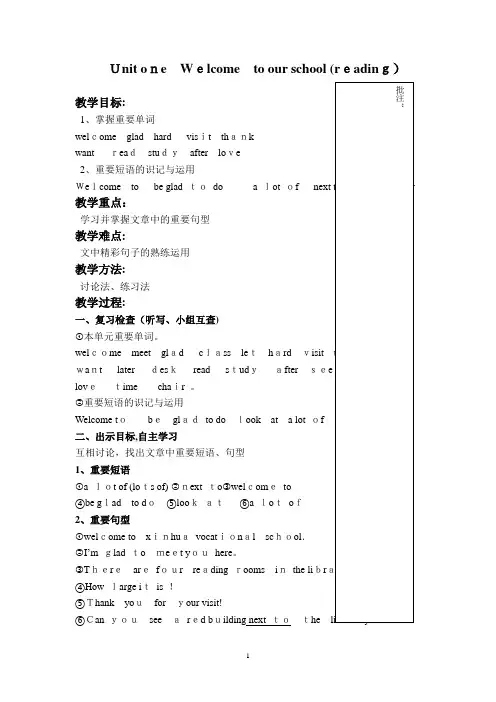
Unit one Welcome to our school (reading)1、掌握重要单词welcome glad hard visit thankwant readstudyafter love2、重要短语的识记与运用Welcome to be glad todo a lot of教学重点:学习并掌握文章中的重要句型教学难点:文中精彩句子的熟练运用教学方法:讨论法、练习法教学过程:一、复习检查(听写、小组互查)①本单元重要单词。
welcome meet glad class lethard visitwant later deskread studyafter selovetime chair 。
②重要短语的识记与运用Welcome tobegladto do look at a lot of二、出示目标,自主学习互相讨论,找出文章中重要短语、句型1、重要短语①a lot of (lots of) ②next to③welcometo④be glad to do⑤lookat⑥a lotof2、重要句型①welcome to xinhuavocational school.②I’m glad tomeet youhere。
③Therearefour reading rooms inthe libr④How large itis !⑤Thank youforyour visit!⑥Can youseeared building next tothe三、知识点导学1、那儿有许多男孩和一个女孩。
2、这楼多么高啊!3、老师的办公室紧挨着我们的教室。
4、在大街上你可以看到很多人。
5、能够帮助你我很高兴。
6、谢谢你的帮助。
填空:1、I’m happy to ________(hear )from you 。
2、There____(be) a computerand four reading roomsin the library。


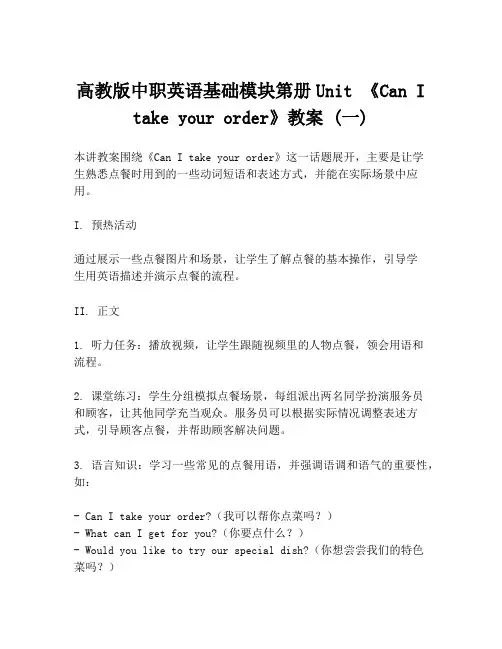
高教版中职英语基础模块第册Unit 《Can I take your order》教案 (一)本讲教案围绕《Can I take your order》这一话题展开,主要是让学生熟悉点餐时用到的一些动词短语和表述方式,并能在实际场景中应用。
I. 预热活动通过展示一些点餐图片和场景,让学生了解点餐的基本操作,引导学生用英语描述并演示点餐的流程。
II. 正文1. 听力任务:播放视频,让学生跟随视频里的人物点餐,领会用语和流程。
2. 课堂练习:学生分组模拟点餐场景,每组派出两名同学扮演服务员和顾客,让其他同学充当观众。
服务员可以根据实际情况调整表述方式,引导顾客点餐,并帮助顾客解决问题。
3. 语言知识:学习一些常见的点餐用语,并强调语调和语气的重要性,如:- Can I take your order?(我可以帮你点菜吗?)- What can I get for you?(你要点什么?)- Would you like to try our special dish?(你想尝尝我们的特色菜吗?)- How would you like your steak?(你想要几分熟的牛排?)- Do you have any food allergies or dietary restrictions?(你是否有食物过敏或饮食禁忌?)4. 表演实践:利用素材提供的对话,让学生分组演练不同场景下的点餐对话,如:在中餐厅点餐、在西餐厅点餐、外卖点餐等。
III. 课堂总结本节课主要让学生学会点餐相关的表达方式和流程,并通过练习增强用英文进行简单交流的能力。
同时,教师也可以将课程扩展到其他场景,如购物、预订酒店等,让学生学会应对不同情境下的交流。
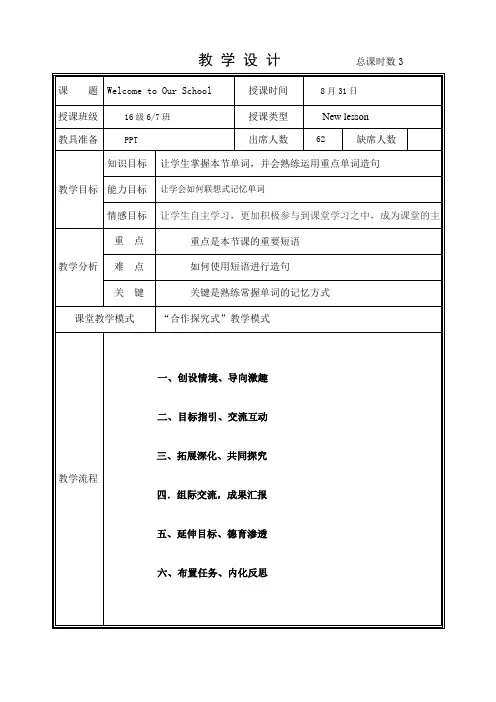

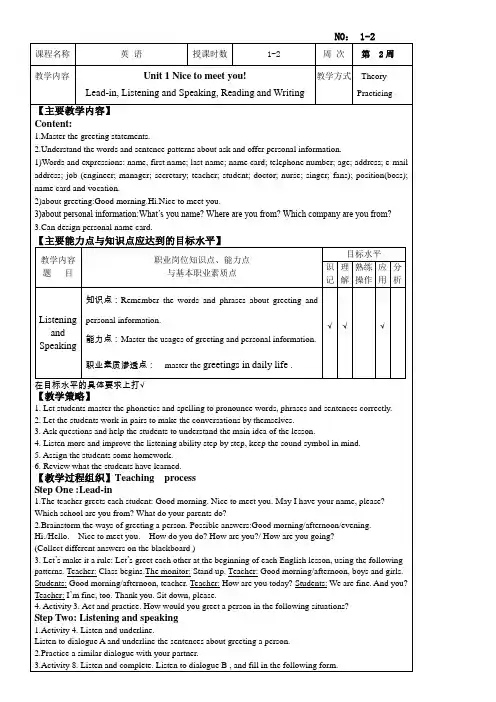
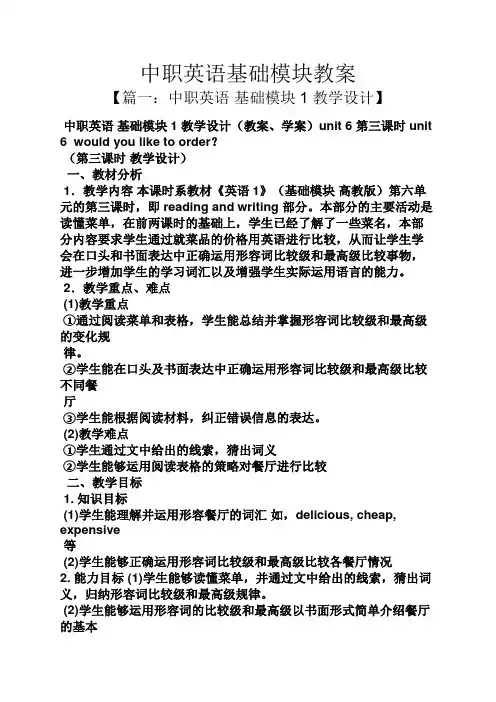
中职英语基础模块教案【篇一:中职英语基础模块1 教学设计】中职英语基础模块1 教学设计(教案、学案)unit 6 第三课时unit 6 would you like to order?(第三课时教学设计)一、教材分析1.教学内容本课时系教材《英语1》(基础模块高教版)第六单元的第三课时,即reading and writing 部分。
本部分的主要活动是读懂菜单,在前两课时的基础上,学生已经了解了一些菜名,本部分内容要求学生通过就菜品的价格用英语进行比较,从而让学生学会在口头和书面表达中正确运用形容词比较级和最高级比较事物,进一步增加学生的学习词汇以及增强学生实际运用语言的能力。
2.教学重点、难点(1)教学重点①通过阅读菜单和表格,学生能总结并掌握形容词比较级和最高级的变化规律。
②学生能在口头及书面表达中正确运用形容词比较级和最高级比较不同餐厅③学生能根据阅读材料,纠正错误信息的表达。
(2)教学难点①学生通过文中给出的线索,猜出词义②学生能够运用阅读表格的策略对餐厅进行比较二、教学目标1. 知识目标(1)学生能理解并运用形容餐厅的词汇如,delicious, cheap, expensive等(2)学生能够正确运用形容词比较级和最高级比较各餐厅情况2. 能力目标 (1)学生能够读懂菜单,并通过文中给出的线索,猜出词义,归纳形容词比较级和最高级规律。
(2)学生能够运用形容词的比较级和最高级以书面形式简单介绍餐厅的基本情况,如路程远近,饭菜价格及质量。
3. 情感目标通过对餐厅的比较,学生外出就餐时能做出理智选择。
三、教学步骤step one lead-in (1min)teacher shows the situation: if you invite your friend to meiwei restaurant to eat out, what would youlike to order for your friend ?(设计意图:教师设定情境,让学生想象邀请朋友用餐。
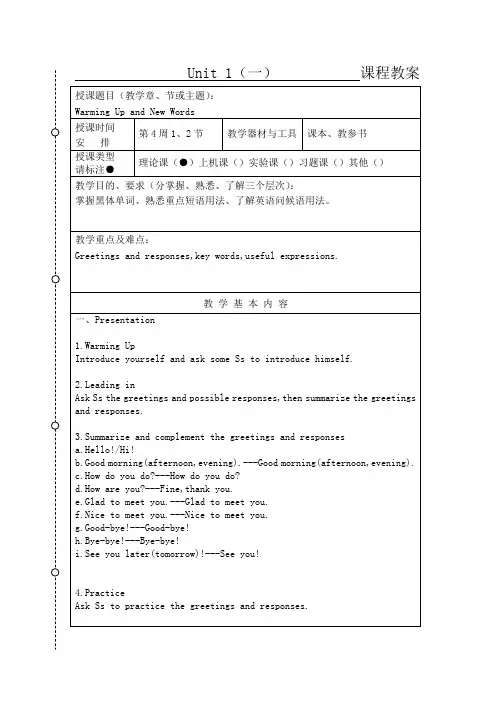
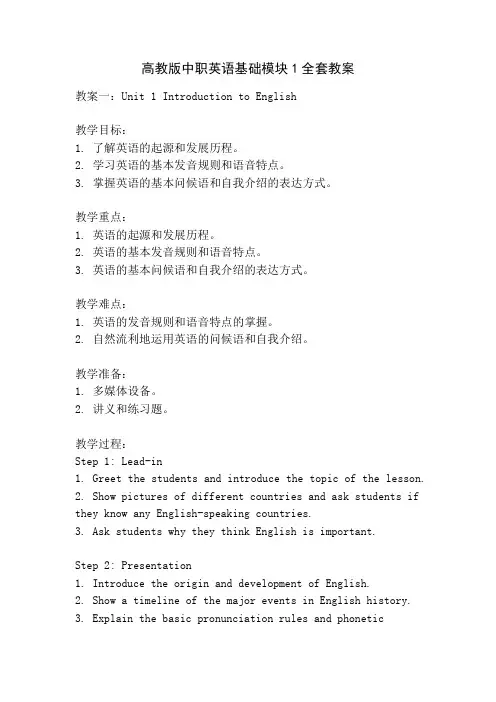
高教版中职英语基础模块1全套教案教案一:Unit 1 Introduction to English教学目标:1. 了解英语的起源和发展历程。
2. 学习英语的基本发音规则和语音特点。
3. 掌握英语的基本问候语和自我介绍的表达方式。
教学重点:1. 英语的起源和发展历程。
2. 英语的基本发音规则和语音特点。
3. 英语的基本问候语和自我介绍的表达方式。
教学难点:1. 英语的发音规则和语音特点的掌握。
2. 自然流利地运用英语的问候语和自我介绍。
教学准备:1. 多媒体设备。
2. 讲义和练习题。
教学过程:Step 1: Lead-in1. Greet the students and introduce the topic of the lesson.2. Show pictures of different countries and ask students if they know any English-speaking countries.3. Ask students why they think English is important.Step 2: Presentation1. Introduce the origin and development of English.2. Show a timeline of the major events in English history.3. Explain the basic pronunciation rules and phoneticfeatures of English.4. Use audio or video materials to demonstrate the correct pronunciation.Step 3: Practice1. Divide the class into pairs or small groups.2. Give students a list of common greetings and ask them to practice using them in different situations.3. Have students practice introducing themselves to each other using the phrases and sentences learned.Step 4: Consolidation1. Review the key points of the lesson, including theorigin and development of English, pronunciation rules, and greetings.2. Ask students to summarize what they have learned intheir own words.Step 5: Assessment1. Give students a short quiz to test their understanding of the lesson.2. Assign homework, such as writing a short paragraph about the importance of English or practicing greetings and self-introductions.教案二:Unit 2 Numbers and Time教学目标:1. 学习基本的数字和时间表达方式。
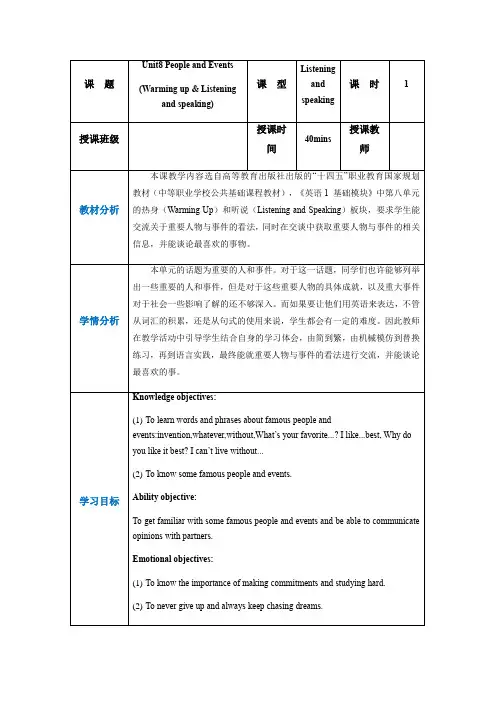
中职英语(基础模块)教案英语(基础模块)教案Unit1ReadyforYourCampusLife⼀、教学⽬标1.谈论⼈名。
2.谈论来⾃何处。
3.介绍⾃⼰所在班级。
4.掌握“主—系—表”结构和“therebe”句型。
5.掌握代词和介词的基本⽤法。
6.学会如何发前元⾳[i:]与[i]⼆、教学向导三、课⽂讲解(⼀)Warm-up1.⽼师⾸先⽤英语向全班学⽣作⾃我介绍,并提出新学习阶段的英语学习要求。
例如:Hello,everyone.Mynameis….I’myourEnglishteacherthisyear.Let’s doourbesttoget hertoimproveourLearningofEnglish.Nowatthebeginningofthisterm,Iwouldliketoadvise youtoplanyourtimecarefully.Besuretohaveenoughtimetorecitethenewwordsandusefule xpression,tolistentoenoughEnglishtapes,toreadmanyEnglisharticles,todooralpracticeas muchaspossibleandtofinishyourhomeworkontime.Second,Iadviseyoutomakegooduseofyourtimeinclass.Listeningcarefullyinclassreallymeanslessworklater.Takingnoteswillhelptoremindyouwhattheteachersaid. AnotherimportantsuggestionisthatyoushoulddevelopagoodattitudetowardsyourEnglishreading,listening,speakingandwriting.Don’tbeafraidofmakingmistakeswhenyouarespeakingEnglish.JusttryyourbesttosaywhatyouwantinEnglisheverytime.I’lldomybesttohelpyouandIhopeeveryonewillgetagreatprogressintheshortestpossib letime….此外,还可以设计⼀些常⽤⼝令、⼿势、规定⼀些纪律,以便在以后的教学中,形成良好的习惯,达成默契。
高教版中职英语(基础模块预备级)Uint1《Hello》word教案课题序号Unit1Hello,everyone(1)授课班级1503授课课时 1 授课形式New授课章节名称或课题Listening and speakingA使用教具recorder教学目标1. To direct Ss to learn to pronounce new words and phrases.2. Enable ss to learn to great each other3. By practing the new words and phrases,help Ss master some language points.教学重点1.Help Ss to pronounce new words and Phrases in this part2.Enable ss to learn to great each other教学难点 1. Some words and Phrases in this part更新、补充、删节内容教学内容和过程师生活动Step 1 Leading-in1.The teacher and the students great each other. The teacher will behin with like this:(1)what did you do in your summer holiday?(2)which do you think is the most interesting thing?(3)Anyone of you travelled outside?2.If someone travelled , ask him /her easy questions like:Can you talk about the interesting places?The other Ss can ask him or her any questions if they want to learn .Step2 Warm-up1.Learn the new words and useful expressions in this unit.2.Greet students in different ways.3.Students look at the pictures and complete the conversations with the correct sentences from the box.4. Students read the titles and use them to role-play a conversation with their partners.Step 3 Listening and Speaking A1. Let the students understand the possible choices.2. Ask the students to guess : What is their relationship? Then listen to the conversation to check their prediction.3. Ask the students to listen again and underline the greetings and introductions in the conversation. 师:导入互动自我介绍生:互动招呼发言师:范读放录音组织设计生:听录音跟读角色演练师:提示鼓励点评生:思考4. Students learn the Useful Expressions.5. Students use the expressions to introduce themselves to their partners.6. Students work in groups of three and complete the conversation .Step 4 Practising of Listening and Speaking A1.Listen to the tape for a third time and circle new difficult words and difficult sentences.2.Ask the Ss to read “learning strategy”, and ask the Ss to think it over before reading the passage.1) First get into groups: Teach a paragraph for the Ss. The Ss read the paragraph silently, then summarize the paragraph in their own words and share their summaries with the group.2) Do the reading and understanding exercises twice so that the Ss have chances to practice their spoken English and check their understating about the dialogue .3) Ask the Ss to underline the points that they don’t understand.4) Ask the Ss to read the article one by one in group, choosea student to take part in competition.Step 5 Further Reading1. Students listen to the tape.2. Students read after the tape and try to express four different ways of greetings using their body language.3. Let the students think over the meaning of four different ways of greetings .4. Provide much more greeting ways in different countries.5. Try to act out each way of greeting.Step6 Language points1.Got it=I’ve got it=I’ve know/understood it2.call(1)call sb.sth(2)call sb. To do sth(3)call on sb.(4)Call at sb’s3.hope(1)hope to do(2)hope that-clause(3)hope, wisheg.wish sb. To do sth(T)4.hope sb. To do sth(F)Step7 SummaryStudents understand different ways of greeting. 练习展示师:举例讲解对比板书生:听记思考比较理解板书设计Unit1 Hello,everyone (1)Language points1.Got it=I’ve got it=I’ve know/understood it2.calla)call sb.sthb)call sb. To do sthc)call on sb.d)Call at sb’s3.hopea)hope to dob)hope that-clausec)hope, wisheg. wish sb. To do sth(T) hope sb. To do sth(F) 课外作业1.学案P1 翻译并背诵词组2.朗读并背诵单词3.熟读对话。